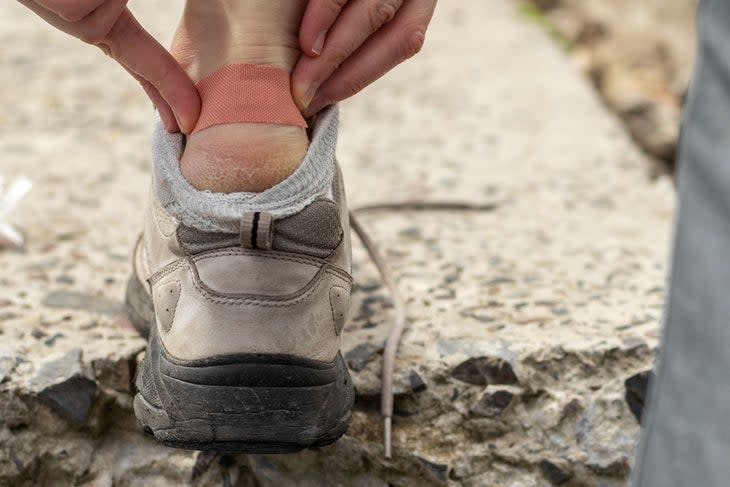The Painful Science of Getting a Blister
This article originally appeared on Backpacker
In Hiking Science, Dan Hu takes an evidence-based look at the way we backpack.
Wondering how a blister forms? The sixth edition of the textbook Wilderness Medicine can explain. Assuming you remember your physics, that is.
"Ff = m * Fn, where m is the coefficient of friction or the ratio of the shear force to normal force that needs to be overcome to initiate movement of the materials relative to the skin." the book helpfully explains. Trust me: It doesn't get any easier from there.
The typical hiker will likely read this, scratch their head, and then give up. Blisters can derail a hike, hard. Have one bubble up in the wrong place and you'll find yourself limping down the trail instead of striding, gritting your teeth with every step. Get enough, or get them bad enough, and you might just find yourself hobbling back to the trailhead instead, bound for a weekend of bad Netflix instead of a weekend of glorious sunrises. Luckily, a little bit of knowledge can help you avoid that fate. Let's break it down--no Greek letters needed.
How does a blister form?
In order to understand how a blister forms, you need to first understand the anatomy of the tissues where the blister is taking place. Your skin has three layers: the epidermis (top layer), the dermis (middle layer), and the underlying subcutaneous tissues, or the hypodermis. Since most hikers will not venture forth barefoot, you usually don't need to worry about cutting or rubbing your feet directly on the ground. Instead, blisters usually form because of the friction between your foot and your shoe.
No boot or shoe, no matter how well-fitted, has a perfect fit. Walking generates shear forces, ultimately resulting in your foot sliding within the boot when these shear forces are able to overcome the friction between your foot, sock, and shoe. With enough time, the sliding will start to distort the upper layers of the skin. Over time, the mechanical fatigue will overcome the integrity of the skin, and the layers will begin to delaminate, or separate from each other.
Once the layers of skin begin to delaminate under shear forces, hydrostatic pressure inside your body results in low-protein, electrolyte-rich fluid entering these spaces. The result is a vesicle--a friction blister. The roof of the blister will be elevated and remain in contact with the pressure points within the foot-sock-shoe complex. You'll start to feel pain from the blister as well, because of the pressure of the fluids within the vesicle.
At this point, it's too late for prevention: You will need to address the blister. Pretending it doesn't exist isn't an option, as continued walking will only generate more shear forces, eventually tearing off the roof of the blister and exposing the raw and sensitive skin beneath.
While an understanding of how blisters happen is helpful, an understanding of the modifiable risk factors is even more so. An ounce of prevention, as they say.

How can you prevent blisters?
In general, blister prevention typically revolves around reducing Ff. For those of you who slept through physics class, that's the frictional forces across the skin. The academic literature offers a number of recommendations for preventive measures, ranging from two-sock systems to chemical compounds to preventive taping:
Foot hygiene (e.g. manicured nails, addressing calluses)
Well-fitting footwear
Sock systems (e.g. using the two-sock method or picking a pair made of a different material)
Antiperspirants, foot powders
Barrier prevention (e.g. taping, pads)
Lubricants (e.g. Chamois Butt'r, Vaseline)
As this is a science-based discussion of blister formation and prevention, inquiring minds may wonder, What's the evidence that any of this stuff works? Unfortunately, the scientific literature may leave the reader with more questions than answers.
A systematic review published in Wilderness and Environmental Medicine in 2017 evaluated prospective controlled trials conducted to evaluate blisters in the setting of wilderness or outdoor activity. The authors identified 11 articles for inclusion in their analyses, which focused on sock systems, antiperspirants, and barriers. Two sock and 2 barrier studies found statistically significant differences between groups for blisters, but no studies in the review found antiperspirants to be effective.
What's more, the authors noted that flaws in the studies' methodology had rendered some of the results questionable. In short: Science doesn't have enough good evidence to develop a clinical strategy for preventing blisters. At this point, most of what we have is anecdotal.
My own personal opinion is that we may never see enough data from high-quality controlled trials on blister prevention. But we don't necessarily need it to figure out what works for us: I don't need a study published in an academic journal to convince me that a well-fitting boot and changing out wet socks will make a difference in preventing blisters. For now, the best strategy is to try different strategies, and figure out what works for you.
For exclusive access to all of our fitness, gear, adventure, and travel stories, plus discounts on trips, events, and gear, sign up for Outside+ today.

